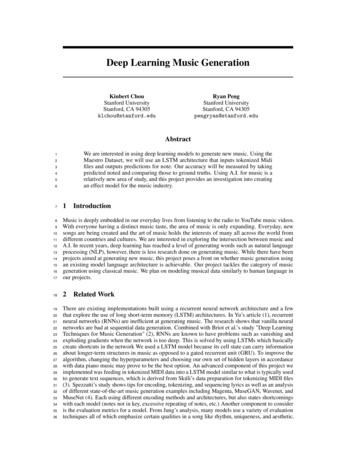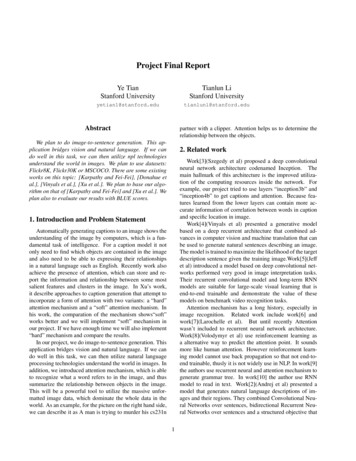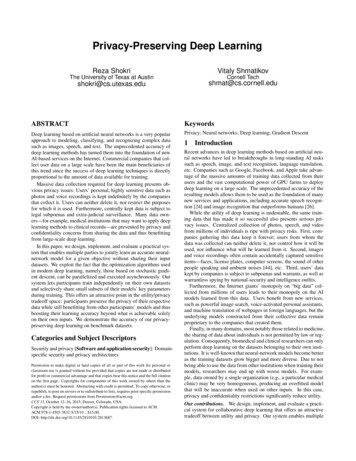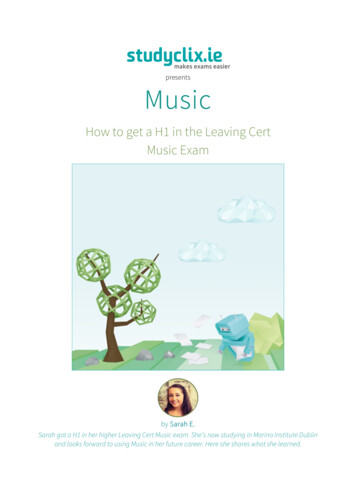
Transcription
Deep Learning Music GenerationRyan PengStanford UniversityStanford, CA 94305pengryan@stanford.eduKinbert ChouStanford UniversityStanford, CA 94305klchou@stanford.eduAbstractWe are interested in using deep learning models to generate new music. Using theMaestro Dataset, we will use an LSTM architecture that inputs tokenized Midifiles and outputs predictions for note. Our accuracy will be measured by takingpredicted noted and comparing those to ground truths. Using A.I. for music is arelatively new area of study, and this project provides an investigation into creatingan effect model for the music industry.12345671Introduction17Music is deeply embedded in our everyday lives from listening to the radio to YouTube music videos.With everyone having a distinct music taste, the area of music is only expanding. Everyday, newsongs are being created and the art of music holds the interests of many all across the world fromdifferent countries and cultures. We are interested in exploring the intersection between music andA.I. In recent years, deep learning has reached a level of generating words such as natural languageprocessing (NLP), however, there is less research done on generating music. While there have beenprojects aimed at generating new music, this project poses a front on whether music generation usingan existing model language architecture is achievable. Our project tackles the category of musicgeneration using classical music. We plan on modeling musical data similarly to human language inour 30313233343536Related WorkThere are existing implementations built using a recurrent neural network architecture and a fewthat explore the use of long short-term memory (LSTM) architectures. In Yu’s article (1), recurrentneural networks (RNNs) are inefficient at generating music. The research shows that vanilla neuralnetworks are bad at sequential data generation. Combined with Briot et al.’s study "Deep LearningTechniques for Music Generation" (2), RNNs are known to have problems such as vanishing andexploding gradients when the network is too deep. This is solved by using LSTMs which basicallycreate shortcuts in the network We used a LSTM model because its cell state can carry informationabout longer-term structures in music as opposed to a gated recurrent unit (GRU). To improve thealgorithm, changing the hyperparameters and choosing our own set of hidden layers in accordancewith data piano music may prove to be the best option. An advanced component of this project weimplemented was feeding in tokenized MIDI data into a LSTM model similar to what is typically usedto generate text sequences, which is derived from Skúli’s data preparation for tokenizing MIDI files(3). Spezzatti’s study shows tips for encoding, tokenizing, and sequencing lyrics as well as an analysisof different state-of-the-art music generation examples including Magenta, MuseGAN, Wavenet, andMuseNet (4). Each using different encoding methods and architectures, but also states shortcomingswith each model (notes not in key, excessive repeating of notes, etc.) Another component to consideris the evaluation metrics for a model. From Jung’s analysis, many models use a variety of evaluationtechniques all of which emphasize certain qualities in a song like rhythm, uniqueness, and aesthetic.
38While most of these metrics are more subjective, Jung proposed an evaluation model that considersthe structure of the song (intro, verse, bridge, chorus, etc.) using a self-similarity matrix (5).39337Dataset and Features47We used the MAESTRO dataset (6) for our project which comes from a leading project in the area ofprocessing, analyzing, and creating music using artificial intelligence. The dataset consists of over200 hours of piano music. The dataset is well defined and cleaned: the dataset includes MIDI filesfrom over ten years of International Piano-e-Competition. The genre for the music files is mostlyclassical with composers from the 17th to early 20th century. The metadata has the following fieldsfor every MIDI/WAV pair: canonical composer, canonical title, split, year, MIDI filename, audiofilename, and duration. We follow the train, validation, and test splits defined by the metadata .csvfile.483.14961All of the data was put into three categories (train, validate, and test). The MIDI files we are workingwith will be read using Music21. The data contains the notes object type and this contains informationabout the pitch, octave, and offset of the note. For the base model there are 967 samples for the trainset, 137 samples for the validation set, and 178 samples for the test set. We start by loading each fileinto a Music21 stream object using the converter.parse(file) function. Then, we get a list of all thenotes in the MIDI file. Next, we append the pitch of every note object using its string representationsince the most significant parts of the note can be recreated using the string notation of the pitch. Wetokenize those string outputs to feed it into the network. For each example, we use a sequence ofthe 100 preceding notes in order to predict the next note. We continue this "sliding window" processuntil we have seen all notes in the file. Our model is fed these inputs of "window," note pairs. Theseencodings allows us to easily decode the output generated by the network into the correct notes. Wewrite this processed data to our data folder and load them at time of training. This preprocessingworkflow is heavily adapted from the work of Sigurður Skúli essingApproach79The current general architecture of our model consists of using a single long short-term memory(LSTM) layer that takes in a sequence of note tokens generated from our data and outputs thepredicted token given our vocabulary. The model takes in the input and passes through three LSTMlayers. The first layer turns the note indexes into hidden state encodings. The second layer thenrefines the hidden state outputs from the first layer. The third layer takes in the refined hidden stateoutputs, and we pass the third layer’s last hidden state to a series of fully-connected layers to makepredictions. This is followed by a layer of batch norm and two linear layers to produce a vector thesame dimensions as our vocabulary size. There is also a layer of batch norm and ReLU activationbetween the linear layers. The last fully connected layer maps the output of the previous linear layerto a vector the length of our vocabulary. We pass this final output to a softmax function, and thisfinal softmax output represents what our prediction for the note is. LSTMs are good at processingsequential data which music is an example of. The notes leading up to a note in question will informthe model of what the next note will be, as the previous notes hold crucial information. For our lossfunction we are using the cross-entropy loss given that we are predicting the next token from our input.We also use the stochastic gradient descent optimizer in our training. We closely follow the structurestated in: r, but recreate the architecture usingPyTorch.805815.182We trained our model on 2839786 examples of (length-100 sequences, next note) pairs generatedfrom roughly 1000 midi files. Training for the model on a p3.2 large instance on AWS took roughly6364656667686970717273747576777883Training and EvaluationTraining2
8436 hours. The following plot diagrams the training loss values over the first 10 epochs.858687Training loss for first 10 epochs88From the progression of loss over iterations, we can see that the loss decreases, albeit minimally, foreach epoch, and roughly achieves the minimum loss at the same point for each epoch. However, foreach epoch, loss can vary widely. We believe this can be explained by the structure of the data: notes,chords, key signatures, and other musical features can vary widely from song to song. Thus, over oneepoch, the model will encounter notes that occur very often, and can update its weights easily, andnotes that occur infrequently in the dataset. Because we are not using embedding representations as dosimilar tasks such as next-word prediction, the model must first learn its own internal representationof each note/chord token. Thus, some songs can be inherently easier because they are in a commonkey signature, and some can be more difficult.89909192939495969798Training loss for our model with batch size 128, epoch 20-10099101For the remaining epochs, the model shows consistent decrease in average loss value over time, butstill oscillates in a large range between easy and hard songs. The range for which the loss oscillates isvery high as compared to a model with a lower batch size.1025.2103We trained a few times using different parameters to analyze loss and accuracy. We trained usinga batch size of 32, 64, and 128. We also trained the model for 30, 50 and 100 epochs to compare.The model with the best results contained a batch size of 128 with 100 epochs. This model achievedlower loss and higher accuracy compared to other models.100104105106Hyperparameter Tuning3
1075.3Results and EvaluationTable 1: Accuracy & Loss for Different ModelsModel128/100 Train128/100 Validation128/100 Test64/85 Train64/85 Validation64/85 Test32/30 Train32/30 Validation32/30 01080.01340.0124Loss1.624.274.811085.4109We observe that while the model does poorly in training accuracy, it performs even worse in dev andtest sets. There are several possible reasons for this: Analysis of our model’s predictions show thatfor Validation and Test sets, it is mostly predicting the notes G or D, at different octaves. These twoare very common notes in many keys in music. During training, the model could have learned topredict these notes frequently to reduce loss. One proposed solution to address this is to train themodel for more epochs, allowing it to learn better representations of input sequences. Additionally,the dev and test sets can possibly come from a different distribution than the training set. Pieces inthese sets can have new key signatures, or new and unseen chords. One suggested improvement toaddress this is to model our input data similar to character embeddings used in NLP deep learningmodels. This will allow the model to generalize its learning to unseen chords.110111112113114115116117118Error Analysis119123Another possible error in the approach is that the vocabulary is simply too complex to learn. To testthis, we train on a significantly reduced dataset, roughly 12% of the actual, and we expect the modelto overfit to this set. However, do to either a low number of epochs (30) or an insufficiently complexmodel, the performance on this smaller dataset is also poor.1246120121122125126127ConclusionWith our training model, the loss does generally decrease with each subsequent epoch. Since thetraining is done with a variety of songs, harder more complex songs have a higher loss to learning. This is mainly seen in the increase and decrease in loss over time within a single training iteration.128129130131132133134Our results show that a batch size of 128 with training under 100 epochs produces the best accuracy.The accuracy for the train set produces a higher accuracy than the test and validation as expected, butis still significantly underfitting. Accuracy is still low as the model requires more epochs, additionaltuning, and possibly a deeper network. For further work, finding a dataset with similar songs may bea good start to improving the baseline for this model. A lot of fluctuations for the loss during trainingattributed to different songs containing notes that are harder to interpret than others.135136137138139140141142143Given the data gathered during this study, the area of music generation requires more training andmodel structure. From other studies, music generation using a LSTM model needs many epochs toaccurately predict next generative notes. This is coupled with a complex multi-layer architecture inmost models for maximum accuracy. In the future, this model can be improved by adding anotherhidden layer and a method for processing unique notes in the validation and test set data. Ultimately,the area of music generation is quite large and once a model is established, there can be more researchdone for different music industries (pop, rock, EDM, etc.) and while piano music generation is a start,building off of these models will be new entry into a creative way to make music.4
6Our work can be found in the LSTMModel folder in the above GitHub repository. get notes() andprepare sequences() is adapted from the Classical-Piano-Composer repository, the work of SigurðurSkúli.147148Github Repo5
149150151152153154155156157References1. -music-generation-97c983b502042. https://arxiv.org/pdf/1709.01620.pdf3. 54. -music-generation-97c983b502045. 1b8e696. https://magenta.tensorflow.org/datasets/maestro6
84 36 hours. The following plot diagrams the training loss values over the first 10 epochs. 85 86 87 Training loss for first 10 epochs 88 From the progression of loss over iterations, we can see that the loss decreases, albeit minimally, for 89 each epoch, and roughly achieves the minimum loss at the same point for each epoch. However, for 90 each epoch, loss can vary widely.











